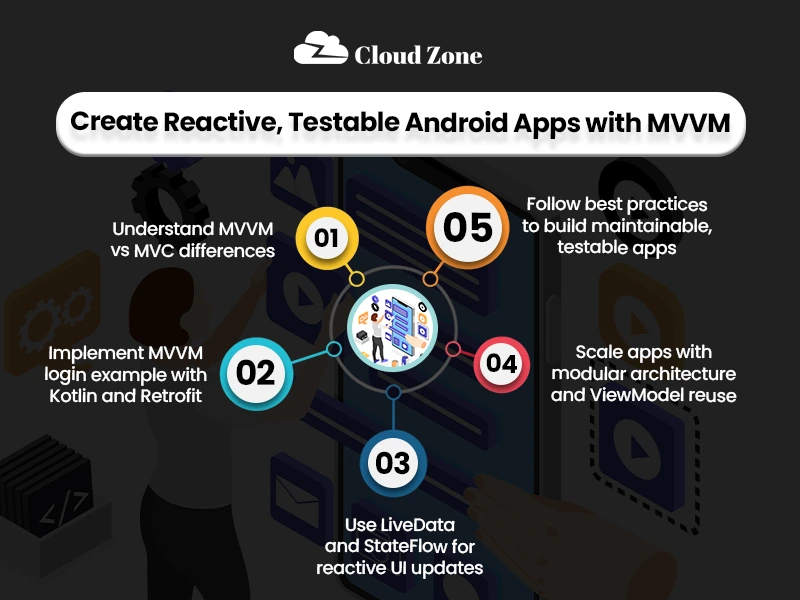Table of Contents
ToggleIntroduction
Have you ever been curious as to why certain Android applications are more responsive, maintainable, and scalable than others? Or What is MVVM?
By the end of this article, you will know how does MVVM work, the difference between MVC and MVVM, and have a practical MVVM login example in Android Kotlin and retrofit that can make your apps sturdy and simple to maintain. These MVVM insights transcend the typical tutorials and reflect on trends within the best development and performance.
The separation of responsibilities in Android development is not merely a best practice in the present context of Android development, but is rather a requirement in Android development to
create apps that are scalable and not chaotic. That’s where MVVM steps in. It enables developers to maintain cleaner code, test more easily, and integrate APIs with little friction by explicitly separating the UI, data, and logic layers.
For the latest updates on cloud infrastructure, explore AWS to invest an additional 2 billion in Indian data centers.
Understanding MVVM Architecture
The MVVM architecture splits concerns into three different layers: Model, View and ViewModel.
Model: Handles business logic and data operations
View: The view is a representation of the UI and the user interaction.
ViewModel: Seats in between the Model and the View, making data available to the UI, but mitigating state changes.
MVVM surely enables developers to separate data management logic and UI logic to enhance testability, maintainability, and scalability. With this in mind, knowing what MVVM pattern is, you will be able to create applications in which the UI automatically responds to changes in data without binding its parts.
To streamline your file management, check out the complete guide to OneDrive for practical tips.

MVVM Login Example in Android Kotlin and Retrofit
In the Model layer, API requests are dealt with by Retrofit.
ViewModel takes in the logic of login and presents LiveData to observe in the UI.
View monitors LiveData and responds to the success or error messages of logins.
Error management is centralized in the ViewModel, which further minimizes the complexity of the UI.
Coroutines are used to make network operations asynchronous, but not to block the main thread.
Data binding eventually helps the mapping of UI components with ViewModels.
In this practical approach, how MVVM works in practice with real-world Android applications, and makes the processes of logins clean, reactive, and maintainable.
Enhance your cloud skills by learning from what is AWS Skill Builder.
Learn how MVVM improves structure, readability, and performance in modern application development today.
How does MVVM work
MVVM is based on the diagram of establishing the reactive flow between the Model, ViewModel, and View. Observable data streams are exposed by the ViewModel, usually with LiveData or MVVM login example Android Kotlin and retrofit. When the Model notifies the View of changes (e.g., by receiving a network call), the ViewModel automatically mirrors such changes to the View. This guarantees that the UI elements are kept in line with the data state without the need for manual intervention.
Learning how does MVVM work can help developers deliver applications in which the updates of the UI can be predicted, tested, and without the boilerplate glue code.
To monitor and analyze systems effectively, explore telemetry.
MVVM vs MVC
- MVC closely binds the Controller and the View, and in large projects, results in incoherent spaghetti code.
- MVVM divides the logic of UI into the ViewModel, which encourages testability and a decoupled architecture.
- MVVM eliminates the possibility of the Controller manually updating the UI.
- MVVM is better-suited to applications with several states of the UI and asynchronous tasks.
- Unit testing MVVM is easier because of the separation of concerns.
- Maintenance and feature addition are less effort than MVC.
MVVM architecture creates a natural workflow between ViewModel, Model, and View layers.
Advantages of MVVM
- An example of this is that it improves maintainability, as it decouples UI and business logic.
- Encourages reusability of ViewModels to several Views.
- LiveData or Flow Reactive programming.
- Minimizes the boilerplate UI update code by data binding.
- Makes unit testing easier because ViewModels can be tested.
- Supported multi-module projects in which the UI and logic are being developed independently.
- With the help of these what is MVVM patterns, developers can develop apps that are simpler to operate, expand, and scale.
Common MVVM Pitfalls
- ViewModel often includes too much non-UI logic and therefore quickly confuses the architecture.
- The direct references to Views in ViewModel conflict with the principle of decoupling.
- Poor LiveData observer management may cause memory leaks.
- Coroutines grow deeply nested; therefore, they easily lower readability and consequently make the code harder to follow.
- The disregard of correct error treatment in the ViewModel has an impact on the user experience.
- Tight coupling is the result of not distinguishing network operations and UI logic.
- One way to avoid these pitfalls is to understand them so that the implementation of your MVVM architecture is clean and sustainable.
MVVM in Multi-Module Android Apps
MVVM actively supports modular architectures, and therefore, it cleanly separates features into distinct modules, ensuring flexibility and scalability. Developers design module-specific ViewModels, and then they easily connect with shared Models to support a reliable, scalable system architecture. Data binding instantly updates the UI, and moreover, dependency-injected modules communicate seamlessly to create a highly reactive and flexible system.
This trend enables large apps to scale quickly and also supports smooth teamwork while further encouraging efficient component reuse.
Safeguard your data by exploring the importance of AWS security training.
Implementing MVVM with LiveData and StateFlow
- They both minimize boilerplate code to update the UI.
- Besides, ViewModel tracks error states and then displays loading indicators and success messages smoothly.
- LiveData + StateFlow are compatible and deliver backwards compatibility and modern reactive design.
- This architecture basically enhances testability and maintainability on asynchronous flows.
- Understanding how MVVM works is an aspect of these tools that will improve the responsiveness of the UI and the quality of code.
Comparing MVC vs MVVM in Android
In MVC vs MVVM comparisons:
- MVC controllers actively merge UI and data logic, and thus, applications lose structure and consequently lose long-term clarity.
- MVVM isolates code, shifting state management of the UI to the ViewModel.
- MVVM data binding certainly minimizes boilerplate code, as is prevalent in MVC.
- MVVM enables reactive UI updates automatically, and therefore it reduces manual work, while MVC often requires imperative, and meanwhile direct, UI changes.
- In MVVM, business logic stays separate from the UI, and therefore testing becomes easier; moreover, developers validate functionality quickly.
- Large-scale Android Projects Large-scale Android projects enjoy the modularity and maintainability of MVVM.
- These disparities explain why MVVM vs MVC arguments support MVVM in contemporary Android development.
Best Practices for MVVM
- Keep ViewModels Viewfree.
- Single-responsibility in each layer.
- Use LiveData or StateFlow to update the UI reactively.
- Manage network requests in repositories in the Model layer.
- Use dependent-injected architecture.
- Test ViewModels on their own to make sure they are reliable and maintainable.
Apps generally made under these best practices of what is MVVM pattern are robust, scalable, and maintainable.

Conclusion
Therefore, mastering what is MVVM? It actually empowers Android developers to build apps that are maintainable, scalable, and reactive. By understanding MVVM architecture, what is MVVM pattern, how MVVM works, implementing MVVM login example Android Kotlin and Retrofit, and following best practices, you can optimize your app’s UI logic and business layers. Further, comparing MVC vs MVVM helps clarify architecture choices, and applying these patterns ensures long-term code health.
Start using MVVM in your Android projects today. Experiment with LiveData, StateFlow, and Kotlin coroutines to build clean, reactive, and testable applications that stand out.
If you want professional cloud training, check out the top 5 cloud computing institutes in Chandigarh.

Sukhamrit Kaur
Sukhamrit Kaur is an SEO writer who loves simplifying complex topics. She has helped companies like Data World, DataCamp, and Rask AI create engaging and informative content for their audiences. You can connect with her on LinkedIn.



